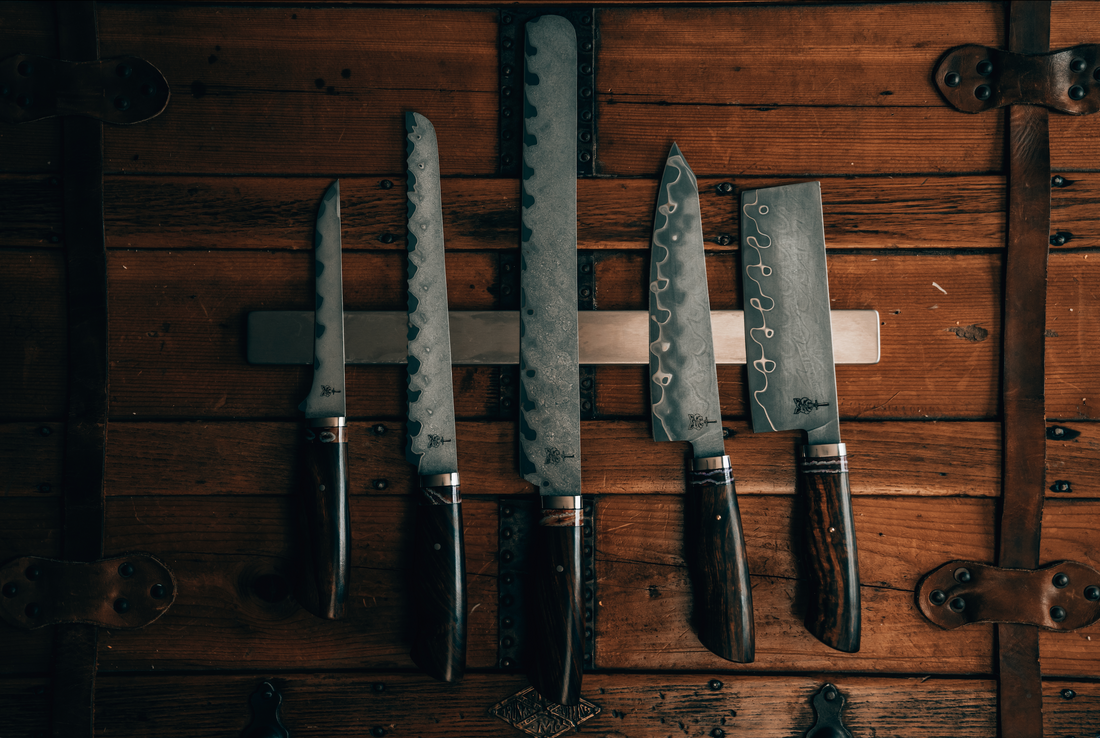One of the first rules a person learns about the kitchen is that a sharp, sturdy, and dependable chef knife set is an essential tool of the trade. Anyone who enjoys preparing food will benefit significantly from investing in a good set of knives. Whether you’re a novice or a professional, there are a handful of characteristics to consider when choosing a professional knife set.
Knife Types
The knives listed below are all essential tools for a professional chef. You will find the first 4 knives to be the most common found in a high end knife set.
Chef’s Knife
A chef knife is a cook’s primary knife. This is one of the most common knives and generally the style of knife that a person would begin with.
Paring Knife
A paring knife is used for preparing small fruits, vegetables, and meat. It’s a small knife that’s ideal for trimming and turning.
Slicing Knife
Another tool for meat-lovers, a slicing knife, is designed for carving roasts and other large pieces of meat into thin, even slices. These knives are generally 8”-12” long and have pointed or rounded tips at the end of a smooth blade.
Cleaver Knife
The cleaver knife. Commonly known as a butcher's knife. Is ideal for chopping and breaking through soft bone and cartilage. These knives are workhorses in the kitchen.
Serrated Bread Knife
A serrated bread knife is good for more than just slicing bread. It can be used for various fruits and vegetables.
Utility Knife
A utility knife has a narrow 5”-6” long blade in both serrated and straight styles. It’s a versatile knife for everyday use.
Boning Knife
If you like cooking meat, a boning knife is a kitchen essential. This thin-bladed tool is designed to maneuver around joints and down bones to separate meat easily.
Material
From stainless and carbon steel to a combination of the two or a different material altogether, this is one major characteristic to understand when you’re looking for a good chef knife set.
Stainless Steel
Stainless steel contains at least 10.5% chromium content. Chromium forms a barrier on the steel making it less susceptible to corrosion. It is generally more common on budget knives and is easier to store and care for. Stainless steels are often less brittle than its cousins due to being softer, but with that it doesn’t hold an edge quite as long, is more prone to scratching and bruises, and can deform under stress.
High Carbon Steel
High Carbon Steel is characterized by having a make up of at least .6% carbon and is often the steel of choice for high-end handmade blades. High carbon steel is often preferred by professionals due to its ability to hold a super sharp edge for a long period of time and ease to quickly sharpen on the job. It is harder and more resistant to wear, but in turn is more brittle and can chip if not taken care of. High carbon steel is more prone to corrosion than stainless and requires a bit more care and upkeep in the form of hand washing, drying, and oiling. The trade off in performance is generally worth the effort.
High Carbon Stainless Steel
Also known as “designer” steel, knives made of this material are the most durable, long-lasting, and easy to use. It generally contains at least .6% carbon and 13% chromium in its make up giving you the best of both worlds, the corrosion resistance of stainless steel and the long lasting super sharp edge of high carbon steel. However you can’t have your cake and eat it too. Many consider it “semi-stainless” since it will still stain and darken with certain foods and can be more difficult to sharpen quickly than pure high carbon steel. These steels are often found in super high end knives and are generally the most expensive of the bunch.
Damascus Steel
Damascus steel is a blend of steels to achieve the beautiful patterns you see in high end knives, generally made with high carbon steel. It was originally created with a unique blend called “Wootz Steel” to create a super performance blade to rival the sub-par steels of the time. Today with modern technology and far superior properties of our steels in general Damascus is mostly aesthetic, though combining the properties of different steels can still be beneficial in creating the ultimate blade. The Damascus you see today is actually made from pattern welded steel, which is the process of forging different steels together and folding them on themselves to create the beautiful wavy patterns.
Types of Handles
Knife handles can be made from several different types of material, including:
- Resin
- Wood
- Composite
- Metal
- Plastic
The handle type a person prefers is mainly a personal decision based on aesthetics and comfort. Regardless of what the handle is made of, no high-quality knife should ever be put into the dishwasher. Over time, the handles will become compromised after all the harsh washing.
Follow the basic guide above to find the perfect professional knife set for you or someone special.

